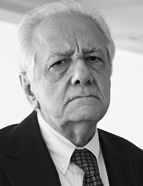

Evaldo Cabral de Mello has always lived in an urban setting, having resided only in Recife until the age of 18. Stimulated by the world of reading from an early age, he was captivated by O touro Ferdinando (translation of The story of Ferdinand by Munro Leaf, USA, 1936) at the age of four. Now a classic of world children's literature, the story would influence him throughout his life, as it helped him recognise the existence of two types of people: some who are agitated and others who are reflective and creative. He made this association in his twenties while reading the philosopher Ortega y Gasset (In M. Hélio, “Eles se detestavam” [They hated each other] 2002, p. 14). He was the only one of his siblings who did not experience the daily life of a sugar mill, which left him feeling frustrated. Perhaps this is why Evaldo Cabral de Mello was profoundly impacted as a teenager by reading Fogo morto [Dead fire] (1943) , by José Lins do Rego, a novel depicting the decline of sugar mill owners — a reality that also impacted his family. The work sparked in him a passion for writing and even led him to consider pursuing a career as a fiction writer. (L.M. Schwarcz and H.M Starling, Três vezes Brasil [Three times Brazil], 2019).
As a teenager, he read Tempo dos Flamengos [Time of the Flemish] (1947), by his historian cousin José Antônio Gonsalves de Mello. It was during this time, as he began to interact with this researcher — one of the foremost experts on the Dutch presence in the Zona da Mata of Pernambuco, who encouraged him to learn 17th-century Dutch — that he was fundamentally influenced to pursue historiographical studies and start publishing in the field. His interest in researching Brazil (particularly Pernambuco) and his appreciation for literature were also nurtured by other close relatives, including his cousin Gilberto Freyre, who wrote the preface for the essay Aspectos da descaracterização do Recife [Aspects of the de-characterisation of Recife] (1951), published by the Grêmio Literário Ruy Barbosa, when Evaldo Cabral de Mello was just 15. In this work, the young author expressed his concern about the rapid growth of the city without regard for preserving the architectural heritage and ecological aspects. The following year, another booklet was published in a similar tone: Recife – uma introdução ao estudo das suas formas e das suas cores [Recife — an introduction to the study of its shapes and colours] (1952) , published by publishing house Região. These writings reflected Evaldo Cabral de Mello's alignment of ideas with Gilberto Freyre, an affinity that did not persist into the historian's later phase, as he himself noted in an interview (R. Bertol, Peripécias de Evaldo Cabral [Peripeteia of Evaldo Cabral], 2003). As for João Cabral de Melo Neto (1920-1999), the poet and diplomat who was Evaldo Cabral de Mello's older brother, he was more influenced by his decision to pursue a career in the civil service than by his interest in literature and the refined narrative style that would characterise Evaldo's career as a historian.
This work is financed by national funds through FCT - Foundation for Science and Technology, I.P, in the scope of the projects UIDB/04311/2020 and UIDP/04311/2020.
